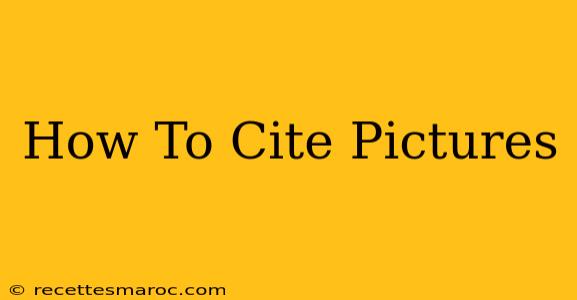Properly citing images is crucial for academic integrity and avoiding plagiarism. Whether you're writing a research paper, creating a presentation, or designing a website, understanding how to cite pictures correctly is essential. This guide provides a comprehensive overview of different citation styles and best practices.
Understanding Image Citation
Citing images involves providing complete and accurate information about the source of the image. This allows readers to easily locate and verify the origin of your visual materials. Failing to cite images can lead to serious consequences, including academic penalties and legal repercussions.
Why Cite Images?
- Avoid Plagiarism: Using images without proper attribution constitutes plagiarism, a serious academic offense.
- Give Credit to Creators: Citing images gives proper credit to the photographers, artists, or organizations who created them. This is a matter of ethical conduct and professional courtesy.
- Enhance Credibility: Proper citation demonstrates your commitment to academic rigor and strengthens the credibility of your work.
- Allow for Verification: Providing complete citation information allows readers to independently verify the source and context of your images.
Common Citation Styles for Images
Different academic disciplines and publication outlets may require specific citation styles. Here are some of the most commonly used styles:
1. MLA (Modern Language Association)
MLA style emphasizes brevity and clarity. Image citations usually appear in the Works Cited page at the end of your paper. The basic format is:
- For online images: Creator's Last Name, Creator's First Name. "Title of Image." Title of Website, Publisher, Date of Publication, URL.
Example:
Doe, John. "Sunset over the Pacific." National Geographic, National Geographic Society, 2023, www.nationalgeographic.com/sunset.
- For images from a book or print source: Creator's Last Name, Creator's First Name. "Title of Image." Title of Book or Publication, Publisher, Year, Page Number(s).
Example:
Smith, Jane. "Impressionist Landscape." Masterpieces of Impressionism, Art Publishing House, 2020, p. 45.
2. APA (American Psychological Association)
APA style focuses on clarity and precision, emphasizing the date of publication. Image sources are typically included in a reference list. The basic format for online images is:
- For online images: Creator's Last Name, Creator's First Name (Year). Title of image. Retrieved from [URL]
Example:
Doe, J. (2023). Sunset over the Pacific. Retrieved from www.nationalgeographic.com/sunset
- For images from a book or print source: Similar to MLA, but with the date of publication emphasized. Include the page number(s) if applicable.
3. Chicago/Turabian
The Chicago style manual offers two main citation formats: notes and bibliography. Image citations usually appear in footnotes or endnotes, followed by a bibliography entry.
-
Footnote/endnote example: 1. John Doe, "Sunset over the Pacific," National Geographic (National Geographic Society, 2023), www.nationalgeographic.com/sunset.
-
Bibliography entry example: Doe, John. "Sunset over the Pacific." National Geographic. National Geographic Society, 2023. Accessed [Date Accessed]. www.nationalgeographic.com/sunset.
Best Practices for Image Citation
Regardless of the citation style you use, follow these best practices:
- Be accurate: Double-check all information, including creator's name, title, publication details, and URL.
- Be consistent: Maintain consistency in your citation style throughout your work.
- Use a citation management tool: Tools like Zotero or Mendeley can help you manage and format your citations.
- When in doubt, ask: If you are unsure about how to cite a specific image, consult your instructor or librarian for assistance.
- Obtain permission: For commercial use or high-profile images, it's important to obtain permission from the copyright holder before using the image.
Common Image Sources and How to Cite Them
- Websites: Always include the website's URL, along with the author's name (if available), the title of the image, and the date of access.
- Books and Journals: Cite the book or journal as you would any other source, including the page number where the image appears.
- Social Media: Citing social media images is trickier and often requires creative solutions including screen shots and proper attribution.
- Stock Photo Websites: These websites offer images for licensing; be sure to adhere to their terms of use and provide correct credit.
Mastering the art of citing pictures not only safeguards you from plagiarism but also demonstrates your commitment to scholarly integrity. By following these guidelines, you can confidently incorporate images into your work while upholding the highest ethical standards.

